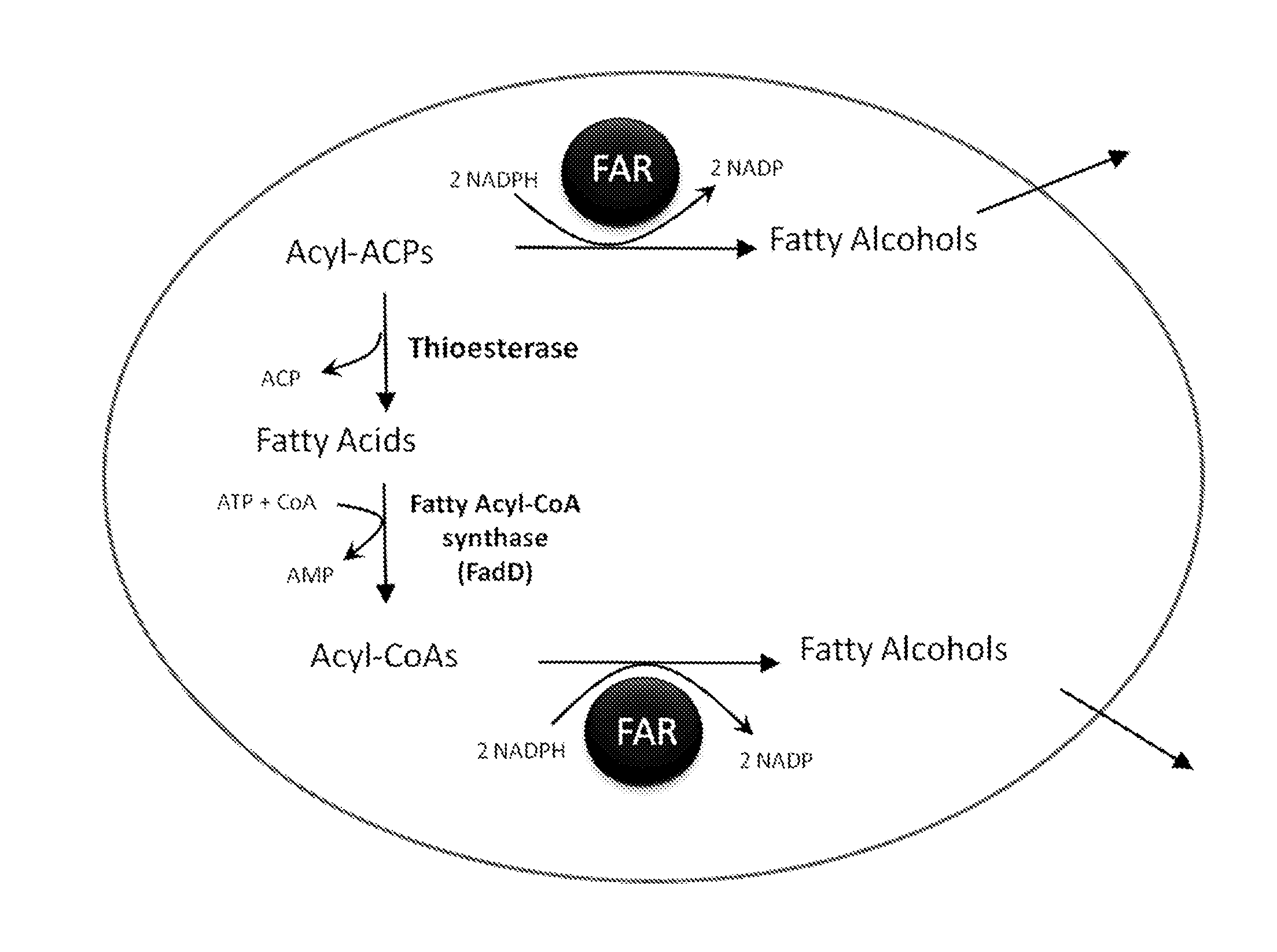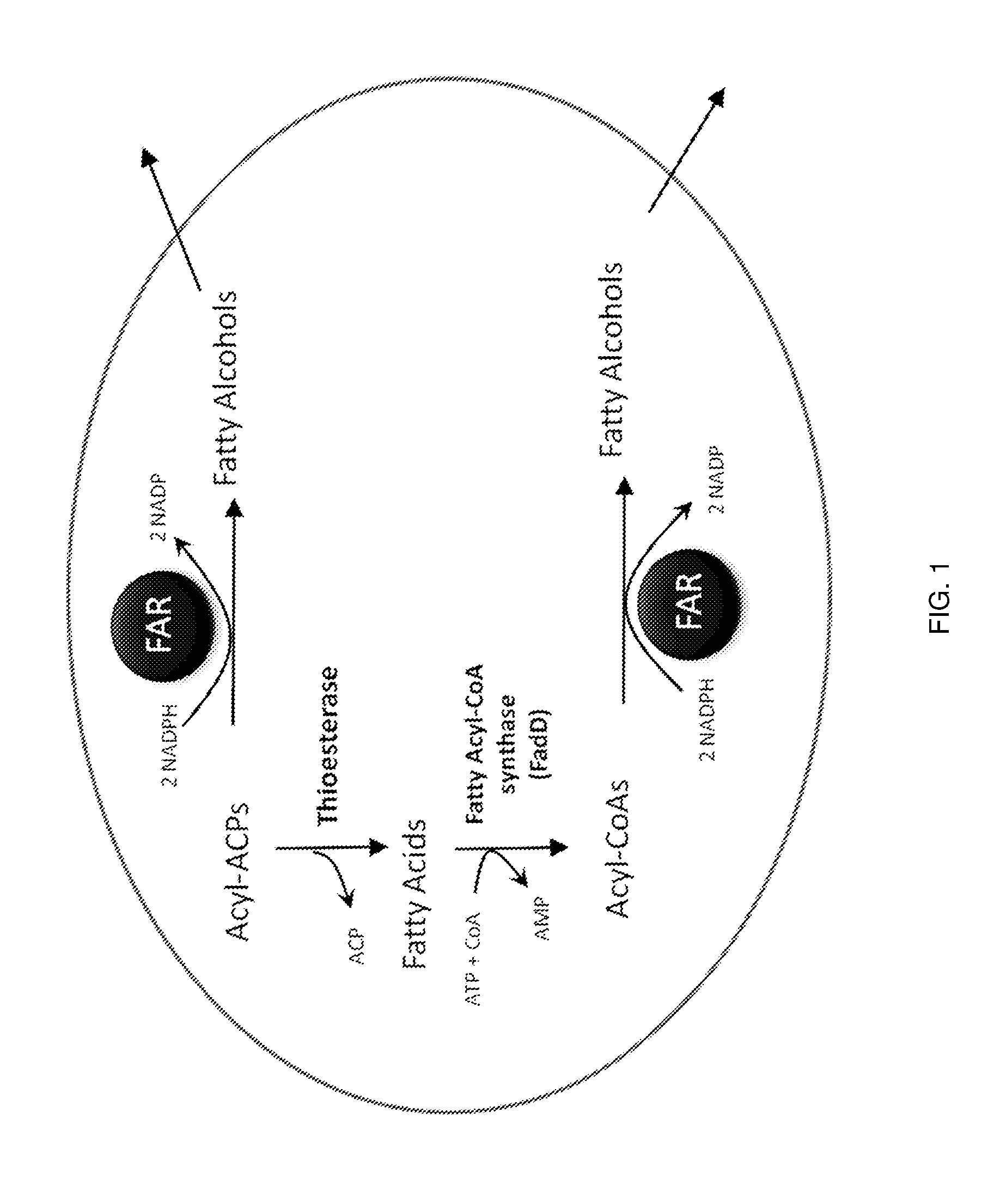Production of fatty alcohols from engineered microorganisms
a technology of engineered microorganisms and fatty alcohols, which is applied in the direction of transferases, bulk chemical production, detergent compounding agents, etc., can solve the problems of reducing the heat stability of fatty alcohol, reducing the shelf life, and requiring a significant amount of energy to obtain fatty alcohol from crude petroleum
- Summary
- Abstract
- Description
- Claims
- Application Information
AI Technical Summary
Benefits of technology
Problems solved by technology
Method used
Image
Examples
example 1
Construction of Plasmid pLS8379
[0185]To overproduce the FAR enzyme having SEQ ID NO:2 in E. coli, a low copy vector carrying the strong Trc promoter was constructed. A DNA fragment containing the lacIq gene, the Trc promoter, and the multiple cloning sites present in pTrcHis2-B (Invitrogen, Carlsbad, Calif.) was PCR amplified using the following primers:
1920TrcM-F(SEQ ID NO: 17)5′-GACCTTAAAACCCTAAAGGCTTAAGGGCATCCGCTTACAGACAand1920TrcM-R(SEQ ID NO: 18)5′-GGAGAAAATACCGCATCAGGCGCCTCAGGAGAGCGTTCACCGAC.
[0186]The PCR reaction was carried out using the enzyme Phusion (New England BioLabs, Ipswich, Mass.) with an initial denaturation step at 98° C. for 30 sec, followed by 25 cycles of the steps: 98° C. for 10 sec; 65° C. for 15 sec and 72° C. for 15 sec. This was followed by a final elongation step at 72° C. for 5 min.
[0187]The primers used for this PCR reaction carry regions of homology to plasmid pCL1920. Because of this, the PCR product described above can be used as a megaprimer to ampl...
example 2
Construction of pCL5019 Comprising a Polynucleotide Encoding the FAR Variant
[0188]A synthetic gene (SEQ ID NO: 3) encoding the FAR polypeptide having SEQ ID NO: 4 was ligated as NcoI-SalI fragments to pLS8379 and digested with the same restriction enzymes. Ligation reactions were incubated overnight at 16° C. and transformed into E. coli DH10B-T1 electrocompetent cells (Invitrogen, Carlsbad, Calif.) following the manufacturer's protocols. Cells were plated on LB agar plates containing 100 micrograms / ml of Spectinomycin. Plates were incubated overnight at 37° C. Obtained clones were sequence verified.
example 3
Construction of pCDX11
[0189]To obtain a tightly regulated gene expression vector, the PTRC promoter present in pLS8379 was replaced with a synthetic DNA fragment containing a PTRC variant where a symmetrical Lac operator [Sadler et al., 1983, PNAS. 80: 6785-6789] was introduced upstream of the −35 region of PTRC. This promoter was synthesized as an EcoRV-NcoI DNA fragment (GeneScript, Piscataway, N.J.) (SEQ ID NO: 19) and used to replace the EcoRV-NcoI region from pLS8379 previously cut with the same restriction enzymes. A ligation reaction containing the two DNA fragments was incubated overnight at 16° C. and then transformed into E. coli Top10 electrocompetent cells (Invitrogen, Carlsbad, Calif.) following the manufacturer's protocols. Cells were plated on LB agar plates containing 100 micrograms / ml of Spectinomycin. Plates were then incubated overnight at 37° C. Obtained clones were sequence verified.
SEQ ID NO: 19GATATCTCGGTAGTGGGATACGACGATACCGAAGACAGCTCATGTTATATCCCGCCGTTAACCACCA...
PUM
| Property | Measurement | Unit |
|---|---|---|
| temperature | aaaaa | aaaaa |
| pH | aaaaa | aaaaa |
| time | aaaaa | aaaaa |
Abstract
Description
Claims
Application Information
 Login to View More
Login to View More - R&D
- Intellectual Property
- Life Sciences
- Materials
- Tech Scout
- Unparalleled Data Quality
- Higher Quality Content
- 60% Fewer Hallucinations
Browse by: Latest US Patents, China's latest patents, Technical Efficacy Thesaurus, Application Domain, Technology Topic, Popular Technical Reports.
© 2025 PatSnap. All rights reserved.Legal|Privacy policy|Modern Slavery Act Transparency Statement|Sitemap|About US| Contact US: help@patsnap.com


